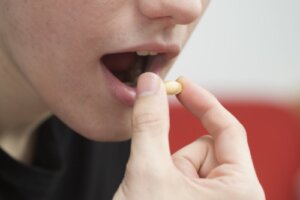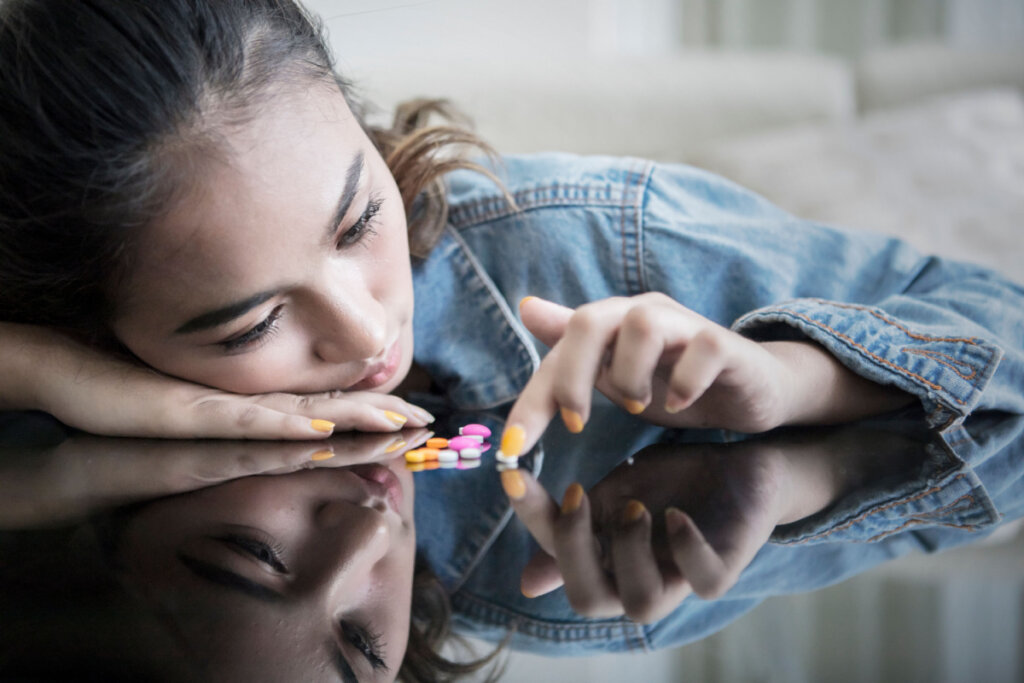The Danger of Addiction to Anxiolytics in Adolescents


Written and verified by the psychologist Elena Sanz
Adolescence is a complex stage. These young people have to process an infinite number of changes on physical, social, and emotional levels. Moreover, they have to face new and more demanding challenges than they ever experienced in childhood.
This can make them feel overwhelmed. They might think that they don’t have the personal resources to navigate their new reality, thus triggering an anxiety disorder. Despite the fact that there are psychological and pharmacological resources to intervene in such situations, it’s important to consider the risk of addiction to anxiolytics in adolescents.
Today, the consumption of these drugs in society has been normalized. That said, they’re far from being harmless. In fact, if used for a long time, anxiolytics become addictive. Then, an increased dose is necessary to obtain their calming effects. In addition, when they’re stopped, the anxiety symptoms return and withdrawal syndrome is possible.
Despite these risks, the consumption of anxiolytics among adolescents has increased worryingly in recent times. We need to know why it’s happening and what can be done about it.

Anxiolytics and their role
Today, anxiolytics are such a common presence, that you’re probably already familiar with the names of some of the main commercial brands. Lorazepam, Trankimazin, Lexotanil, Valium… these drugs can be found in the medicine cabinets of many families and are consumed by a large part of the population. But, what are they?
An anxiolytic (or minor tranquilizer) is a psychotropic drug. It has a depressant action on the central nervous system. It works by slowing down the rhythm and functions of the body and producing effects of relaxation and drowsiness. For this reason, it’s mainly used in the treatment of anxiety, insomnia, and other psychological disorders.
The vast majority of prescription anxiolytics are from the benzodiazepine family. These drugs act in the brain on the GABA (gamma amino-butyric acid) receptor, the main inhibitory neurotransmitter in humans. They enhance the activity of GABA, thus inhibiting the central nervous system and generating the aforementioned functions. However, they’re really addictive substances.
Addiction to anxiolytics and adolescents
Today, anxiolytics are the third most commonly consumed drug (behind alcohol and tobacco). They’re also among the most used by adolescents. Indeed, the consumption of these drugs among young people has increased in recent times. In fact, it’s estimated that they often take them as early as 14-15 years.
One in five minors claims to have used anxiolytics sporadically. While half of them had a medical prescription, the other half didn’t. It seems there’s a tendency among young people to consume these types of drugs as a form of leisure. They generally combine them with alcohol, hence significantly increasing the risks to which they’re exposed.
As we said earlier, anxiolytics aren’t harmless. Their main side effects include dizziness, confusion, poor coordination, pronunciation and memory problems, erroneous judgment, and sudden mood changes. These consequences can be long-lasting.
Even more dangerous is their high addictive potential. In fact, whether or not they’re used under medical prescription, anxiolytics can generate addiction in an extremely short time. It’s estimated that one in three people begin to develop dependence just four weeks after starting treatment.
This means that not only do these drugs lose effectiveness over time and generate tolerance in the user, but trying to stop using them can be really difficult. Withdrawal symptoms (physical and psychological) include anxiety and nervousness, sleep disturbances, irritability, physiological disturbances, and, in severe cases, confusion and hallucinations.
Preventing addiction to anxiolytics in adolescents
In light of the above, we shouldn’t take the upward trend in adolescents taking anxiolytics lightly. Indeed, it’s key that we begin to prevent addiction to anxiolytics in these young people. But how can it be achieved? It’s a task that society as a whole, must assume. The following steps should be taken:
Avoid self-medication
Sometimes, people decide to take drugs that they believe can help them, but that carry serious risks. Although anxiolytics require a prescription, they can usually be found in the family medicine cabinet and young people may decide to take them in moments of crisis or anxiety. However, it’s essential to prevent this from happening. Therefore, prior professional assessment should always be sought.
Limiting access
Along the same lines, it’s important that, if there are anxiolytics at home, they’re kept in a place with restricted access. After all, many adolescents begin to consume anxiolytics or take them frequently because they can access them so easily.
The control of prescriptions
Health professionals also play a crucial role. They need to be really selective when it comes to prescribing medication. It’s essential that, when they issue a prescription for anxiolytics, they also evaluate the individual, and implement a follow-up plan. This should include a date for quitting the medication.
It’s worth remembering that anxiolytics can help in the short term, but they’re not a solution in themselves. As an analogy, they could be seen as crutches after a sprain.

Making young people aware
Finally, adolescents must be informed of the risks involved in the consumption of these drugs and what their effects and consequences may be. As they’re legal drugs, young people are often not aware of the implications of consuming them.
Adolescents are a vulnerable population. The consumption of anxiolytics can cause serious effects in them, both in the short and long term. In the event that they experience any discomfort, sleep disturbances, or anxiety problems, they should visit a professional. They can make an appropriate diagnosis, prescribe a treatment, and supervise its usage.
Adolescence is a complex stage. These young people have to process an infinite number of changes on physical, social, and emotional levels. Moreover, they have to face new and more demanding challenges than they ever experienced in childhood.
This can make them feel overwhelmed. They might think that they don’t have the personal resources to navigate their new reality, thus triggering an anxiety disorder. Despite the fact that there are psychological and pharmacological resources to intervene in such situations, it’s important to consider the risk of addiction to anxiolytics in adolescents.
Today, the consumption of these drugs in society has been normalized. That said, they’re far from being harmless. In fact, if used for a long time, anxiolytics become addictive. Then, an increased dose is necessary to obtain their calming effects. In addition, when they’re stopped, the anxiety symptoms return and withdrawal syndrome is possible.
Despite these risks, the consumption of anxiolytics among adolescents has increased worryingly in recent times. We need to know why it’s happening and what can be done about it.

Anxiolytics and their role
Today, anxiolytics are such a common presence, that you’re probably already familiar with the names of some of the main commercial brands. Lorazepam, Trankimazin, Lexotanil, Valium… these drugs can be found in the medicine cabinets of many families and are consumed by a large part of the population. But, what are they?
An anxiolytic (or minor tranquilizer) is a psychotropic drug. It has a depressant action on the central nervous system. It works by slowing down the rhythm and functions of the body and producing effects of relaxation and drowsiness. For this reason, it’s mainly used in the treatment of anxiety, insomnia, and other psychological disorders.
The vast majority of prescription anxiolytics are from the benzodiazepine family. These drugs act in the brain on the GABA (gamma amino-butyric acid) receptor, the main inhibitory neurotransmitter in humans. They enhance the activity of GABA, thus inhibiting the central nervous system and generating the aforementioned functions. However, they’re really addictive substances.
Addiction to anxiolytics and adolescents
Today, anxiolytics are the third most commonly consumed drug (behind alcohol and tobacco). They’re also among the most used by adolescents. Indeed, the consumption of these drugs among young people has increased in recent times. In fact, it’s estimated that they often take them as early as 14-15 years.
One in five minors claims to have used anxiolytics sporadically. While half of them had a medical prescription, the other half didn’t. It seems there’s a tendency among young people to consume these types of drugs as a form of leisure. They generally combine them with alcohol, hence significantly increasing the risks to which they’re exposed.
As we said earlier, anxiolytics aren’t harmless. Their main side effects include dizziness, confusion, poor coordination, pronunciation and memory problems, erroneous judgment, and sudden mood changes. These consequences can be long-lasting.
Even more dangerous is their high addictive potential. In fact, whether or not they’re used under medical prescription, anxiolytics can generate addiction in an extremely short time. It’s estimated that one in three people begin to develop dependence just four weeks after starting treatment.
This means that not only do these drugs lose effectiveness over time and generate tolerance in the user, but trying to stop using them can be really difficult. Withdrawal symptoms (physical and psychological) include anxiety and nervousness, sleep disturbances, irritability, physiological disturbances, and, in severe cases, confusion and hallucinations.
Preventing addiction to anxiolytics in adolescents
In light of the above, we shouldn’t take the upward trend in adolescents taking anxiolytics lightly. Indeed, it’s key that we begin to prevent addiction to anxiolytics in these young people. But how can it be achieved? It’s a task that society as a whole, must assume. The following steps should be taken:
Avoid self-medication
Sometimes, people decide to take drugs that they believe can help them, but that carry serious risks. Although anxiolytics require a prescription, they can usually be found in the family medicine cabinet and young people may decide to take them in moments of crisis or anxiety. However, it’s essential to prevent this from happening. Therefore, prior professional assessment should always be sought.
Limiting access
Along the same lines, it’s important that, if there are anxiolytics at home, they’re kept in a place with restricted access. After all, many adolescents begin to consume anxiolytics or take them frequently because they can access them so easily.
The control of prescriptions
Health professionals also play a crucial role. They need to be really selective when it comes to prescribing medication. It’s essential that, when they issue a prescription for anxiolytics, they also evaluate the individual, and implement a follow-up plan. This should include a date for quitting the medication.
It’s worth remembering that anxiolytics can help in the short term, but they’re not a solution in themselves. As an analogy, they could be seen as crutches after a sprain.

Making young people aware
Finally, adolescents must be informed of the risks involved in the consumption of these drugs and what their effects and consequences may be. As they’re legal drugs, young people are often not aware of the implications of consuming them.
Adolescents are a vulnerable population. The consumption of anxiolytics can cause serious effects in them, both in the short and long term. In the event that they experience any discomfort, sleep disturbances, or anxiety problems, they should visit a professional. They can make an appropriate diagnosis, prescribe a treatment, and supervise its usage.
All cited sources were thoroughly reviewed by our team to ensure their quality, reliability, currency, and validity. The bibliography of this article was considered reliable and of academic or scientific accuracy.
- Observatorio Español de las Drogas y las Adicciones. Informe 2021. Alcohol, tabaco y drogas ilegales en España.
Madrid: Ministerio de Sanidad. Delegación del Gobierno para el Plan Nacional sobre Drogas; 2021. 243 p. - Observatorio Español de las Drogas y las Adicciones. Encuesta sobre uso de drogas en enseñanzas secundarias en España (ESTUDES), 1994-2021. Madrid: Ministerio de Sanidad. Delegación del Gobierno para el Plan Nacional sobre Drogas; 2021. 148 p.
This text is provided for informational purposes only and does not replace consultation with a professional. If in doubt, consult your specialist.







